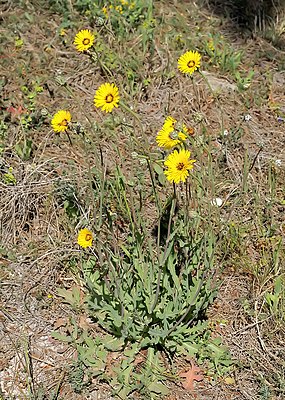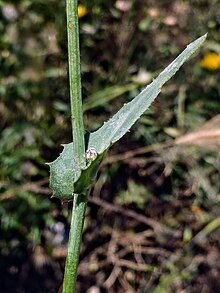Tangier Reichardie
| Tangier Reichardie | ||||||||||||
|---|---|---|---|---|---|---|---|---|---|---|---|---|

Tangier Reichardia ( Reichardia tingitana ) |
||||||||||||
| Systematics | ||||||||||||
|
||||||||||||
| Scientific name | ||||||||||||
| Reichardia tingitana | ||||||||||||
| ( L. ) Roth |
Reichardia tingitana , the German common name Tangier-Reichardie is used, is a species of the genus Reichardia in the sunflower family (Asteraceae).
description
Vegetative characteristics
The Tangier Reichardia grows as an annual, biennial or perennial herbaceous plant that reaches heights of 5 to 40 centimeters. The stem contains milk juice .
The leaves, which are arranged in a basal rosette and distributed on the stem, are glabrous and smooth to densely white papillae. The basal leaves are 2 to 27 centimeters long and 0.5 to 7 centimeters wide, toothed or pinnately fissured and with a short stalk at the base and narrowed into a broadly winged petiole. The stem leaves are sessile and more or less encompassing the stem.
Generative characteristics
The flowering period is March to June. The terminal, cup-shaped inflorescences , which have a diameter of 2 to 2.5 centimeters, are located individually on the slightly thickened inflorescence shafts, some of which are covered with small bracts . The outer bracts are heart-shaped or ringed, with wide skin margins and a small tooth below the tip. The flower heads contain only ray florets. The ray-florets are yellow, at the base purple, the marginal outside with red stripes and about twice as long as the envelope.
The achenes are 1.5 to 2.5 millimeters long, square or pentagonal and all wrinkled crosswise. There is a pappus.
The number of chromosomes is 2n = 16.
distribution
The Tangier Empire is widespread from the Canary Islands across the Mediterranean to Western Asia. It thrives on sand and rocks near the coast.
Taxonomy
It was first published in 1753 under the name ( Basionym ) Scorzonera tingitana by Carl von Linné in Species Plantarum , page 791. The new combination to Reichardia tingitana (L.) Roth was published in 1787 by Albrecht Wilhelm Roth in Botanische Abhandlungen , page 35. Further synonyms for Reichardia tingitana (L.) Roth are: Scorzonera orientalis L. , Picridium arabicum DC. , Picridium discolor Pomel , Picridium orientale (L.) DC. , Reichardia arabica (DC.) Fiori , Reichardia orientalis (L.) Hochr.
Individual evidence
- ↑ a b c d e f g h Peter Schönfelder , Ingrid Schönfelder: The new cosmos Mediterranean flora. Franckh-Kosmos-Verlag Stuttgart 2008, ISBN 978-3-440-10742-3 , p. 132.
- ↑ a b c d Peter Derek Sell: Reichardia Roth. , Pp. 325-326. In: Thomas Gaskell Tutin et al .: Flora Europaea . Volume 4: Plantaginaceae to Compositae (and Rubiaceae). Cambridge University Press 1976, ISBN 0-521-08717-1 . ( limited preview in Google Book search)
- ^ Reichardia tingitana at Tropicos.org. In: IPCN Chromosome Reports . Missouri Botanical Garden, St. Louis
- ↑ Werner Greuter (2006+): Compositae (pro parte majore). In: Werner Greuter, E. von Raab-Straube (Ed.): Compositae. Datasheet Reichardia tingitana In: Euro + Med Plantbase - the information resource for Euro-Mediterranean plant diversity .
- ^ Reichardia tingitana at Tropicos.org. Missouri Botanical Garden, St. Louis, accessed July 27, 2020.
Web links
- Thomas Meyer, Michael Hasler: Mediterranean and Alpine flora. Data sheet with photos.



